#Alcoholuse
Explore tagged Tumblr posts
Text
Lake Avenue Recovery Center: Beacon of Hope

Understanding the Crisis
Before delving into the treatment programs, it's crucial to grasp the magnitude of the addiction crisis in Massachusetts. The state has faced its share of substance abuse challenges, grappling with opioids, alcohol, and various other drugs that have left an indelible mark on individuals and families alike. The Alarming Statistics In 2020, Massachusetts experienced 2,104 opioid-related overdose deaths, highlighting the severity of the opioid crisis in the state. Furthermore, there were 46,477 admissions to substance abuse treatment programs in 2019, emphasizing the significant demand for support and recovery resources. According to the National Survey on Drug Use and Health, approximately 7% of adults in Massachusetts reported heavy alcohol use in the past month, with 14% engaging in binge drinking. Among underage drinkers, approximately 12% reported engaging in binge drinking, raising concerns about the health and safety of young people.
The State's Multifaceted Approach
Massachusetts is not just a state of urban centers; it also comprises rural regions. This diverse landscape contributes to the multifaceted challenges of underage drinking, necessitating targeted approaches and resources. In light of these facts and figures, it becomes evident that Massachusetts recognizes the urgency of addressing substance abuse. The state has embraced a multifaceted and holistic approach to addiction treatment, aiming to provide comprehensive support to those affected. Diverse Addiction Treatment Programs Massachusetts boasts a broad spectrum of addiction treatment programs, ensuring that individuals grappling with substance abuse can access the care and resources they need. These programs encompass various levels of care, catering to diverse needs and circumstances. Spotlight on Lake Avenue Recovery Center Lake Avenue Recovery Center, established in 2020, offers evidence-based treatment and support for addiction in Massachusetts. Its team of professionals uses modern technology to provide tailored care and resources, aiming to build long-term sobriety for patients. Comprehensive Care at Lake Avenue Recovery Lake Avenue Recovery treats various addictions, including alcohol abuse, opioid use disorder, and methamphetamine use disorder. They offer a wide range of personalized services, including therapy, medication management, peer support, and holistic therapies, with a focus on long-term recovery. Post-Treatment Support Moreover, the center provides a comprehensive aftercare plan, including 12-step meetings, relapse prevention workshops, peer support networks, nutrition classes, and life skills education courses, to help individuals maintain sobriety post-treatment.
A Beacon of Hope
Lake Avenue Recovery, a Massachusetts-based addiction treatment center, has significantly impacted individuals, families, and communities by providing quality care, reducing drug abuse rates, and offering resources and support for those struggling with addiction, setting an example for other centers.
Commitment to Recovery
While addiction may cast a long shadow, Massachusetts is committed to illuminating the path to healing and recovery. By offering a diverse array of treatment programs, emphasizing prevention and education, and addressing the specific challenges of underage drinking, the state strives to create a supportive environment for all its residents. A Steadfast Commitment The statistics and facts mentioned earlier underscore the urgency of these efforts. With a steadfast commitment to the well-being of its citizens, Lake Avenue Recovery Center in Massachusetts serves as a beacon of hope for individuals and families affected by addiction. In the face of adversity, the state's dedication to recovery remains unwavering, illuminating the road toward a brighter, healthier future for all. Sources: THX News & Lake Ave Recovery. Read the full article
#Aftercaresupport#Alcoholuse#AlcoholuseinMassachusetts#Beaconofhope#Evidence-basedtreatment#LakeAvenueRecovery#Long-termsobriety#Massachusettsaddictiontreatment#Massachusettsaddictiontreatmentprograms#Opioidcrisis#Opioidcrisisstatistics#Substanceabusecrisis#SubstanceabusecrisisinMassachusetts#Underagedrinking#UnderagedrinkinginMA
0 notes
Text
First meeting Coop accidentally scares the Drunk so badly he runs into a wall and blacks out
I love the thought of coop just freaking him out all the time when it really just likes him for no particular reason (or maybe it can read him through his shadow.)
#coopdrunk#alcoholusion#<-I can’t believe I haven’t been using this sooner….Ceris you genius#brewbabbl
6 notes
·
View notes
Text
🧠 Chi-Square Realness: Alcohol vs. Marital Status 🍷💔💍
Using data from the NESARC survey, we dug into how your relationship status might influence how much you drink. The stats? Unfiltered and telling.
📊 Key Insight:
There’s a significant association between marital status and alcohol consumption (Chi² = 392.18, p < .001).
Married individuals top the charts across all drinking levels.
Divorced/Separated drink moderately — but steadily.
Never Married lean toward lighter drinking, but mid-range isn't rare.
Widowed appear quietly in higher consumption brackets. (Coping, perhaps?)

⚖️ Pairwise Comparisons:
We broke it down further with post-hoc testing:
Married vs Never Married → Big difference (p < .001)
Married vs Divorced/Cohabiting → Still distinct (p < .01)
Never Married vs Separated → Subtle, yet significant (p ≈ .015)



Your marital status might be quietly shaping your drinking habits — whether you're toasting to love, numbing the breakup, or just navigating life solo. In case you want to try the code yourself ````````````````````````
import pandas as pd import numpy as np import scipy.stats as stats import seaborn as sns import matplotlib.pyplot as plt
Load the dataset
data = pd.read_csv('nesarc.csv', low_memory=False)
Convert variables to numeric
data['S2AQ8A'] = pd.to_numeric(data['S2AQ8A'], errors='coerce') # Alcohol frequency data['MARITAL'] = pd.to_numeric(data['MARITAL'], errors='coerce') # Marital status
Subset data (assuming sub1 already exists — else, create one)
sub1 = data.copy() sub2 = sub1.copy()
Replace invalid or missing codes with NaN
sub2['S2AQ8A'].replace([99, np.nan], np.nan, inplace=True) sub2['MARITAL'].replace(9, np.nan, inplace=True)
Filter only valid values
sub2 = sub2[(sub2['S2AQ8A'].between(1, 10)) & (sub2['MARITAL'].between(1, 6))]
Create a label-friendly MARITALSTATUS column (you can use actual labels instead of scores)
marital_map = { 1: 'Married', 2: 'Cohabiting', 3: 'Widowed', 4: 'Divorced', 5: 'Separated', 6: 'Never Married' } sub2['MARITALSTATUS'] = sub2['MARITAL'].map(marital_map)
-------------------------
🔍 Main Chi-Square Test
-------------------------
ct_main = pd.crosstab(sub2['S2AQ8A'], sub2['MARITALSTATUS']) print("Main Contingency Table:\n", ct_main)
print("\nColumn Percentages:\n", ct_main / ct_main.sum(axis=0))
chi2, p, dof, expected = stats.chi2_contingency(ct_main) print("\nChi-square test results:") print(f"Chi2 Value: {chi2:.2f}") print(f"p-value: {p:.4f}") print(f"Degrees of Freedom: {dof}") print("Expected Counts:\n", pd.DataFrame(expected, index=ct_main.index, columns=ct_main.columns))
-------------------------
📊 Visualization
-------------------------
plt.figure(figsize=(12, 6)) sns.countplot(data=sub2, x='MARITALSTATUS', hue='S2AQ8A', palette='Set2') plt.title("Drinking Frequency by Marital Status") plt.xlabel("Marital Status") plt.ylabel("Count of Respondents") plt.legend(title="Drinking Frequency Code", bbox_to_anchor=(1.05, 1), loc='upper left') plt.tight_layout() plt.show()
-------------------------
🔁 Optional: Pairwise Comparisons
-------------------------
def chi_square_pairwise(df, group_col, compare_col, groups): sub_df = df[df[group_col].isin(groups)] ct = pd.crosstab(sub_df[compare_col], sub_df[group_col]) chi2, p, dof, expected = stats.chi2_contingency(ct) print(f"\nChi-square for {groups[0]} vs {groups[1]}") print(f"Chi2: {chi2:.2f}, p-value: {p:.4f}, DOF: {dof}") print("Contingency Table:\n", ct)
Run pairwise tests
pairwise_groups = ('Married', 'Never Married'), ('Married', 'Divorced'), ('Married', 'Cohabiting'), ('Never Married', 'Separated')
for g1, g2 in pairwise_groups: chi_square_pairwise(sub2, 'MARITALSTATUS', 'S2AQ8A', [g1, g2])
````````````````````````
#DataScience #MentalHealth #NESARC #Sociology #ChiSquare #AlcoholUse #Relationships #ResearchVibes
0 notes
Photo

Have you noticed a change in your moods or behavior lately? You're not alone! With the sun going down around 5PM you might feel more anxious, depressed or notice a distinct lack of energy. The good news is that there are ways to push back against that feeling; exercising, eating healthy & limiting alcohol or drug use can all help you regain that sense of normalcy! #EvansvilleWI #BASEvansville #SeasonalDepression #AlcoholUse #Prevention #MentalHealth (at Evansville, Wisconsin) https://www.instagram.com/p/CHvP_4pA8-Z/?igshid=x84eidqdcv10
0 notes
Link
JADE Wellness Center specializes in treating alcohol use disorder. Our physicians are some of the most knowledgeable on this topic. If you or a loved one are struggling with alcohol use you are not alone. Call us today to learn about all the new options available to treat this disease. 412-380-0100 or visit http://www.myjadewellness.com
#alcoholawareness#jadewellnesscenter#alcoholdisorder#alcoholtreatment#alcoholuse#addiction#recovery#drugaddiction#drugtreatment#alcoholrehab#drugrehab#drugabusetreatmentcenter
0 notes
Text
First Assignment
To the first assignment of Wesleyan University’s Data Management and Visualization, I’ve chosen NESARC as the dataset of my project, in order to study specific topics about alcoholism. I’ve decided to study the association between alcohol consumption and alcohol dependence. While reading NESARC’s Codebook, I’ve printed some variables of interest in the sections about the topics I’ve chosen – consumption (2A) and dependence (2B). My primary hypothesis is that the more a person drinks alcohol, the more they are susceptible to becoming addicted to alcohol.
For better understanding the theme, I did a brief review of the recent literature there is about this subject, using the terms “alcohol consumption” and “alcohol dependence” in PubMed, also applying the filter “last 5 years” and, later, “Systematic Review”. That search returned 3 interesting and recent articles.
The first of them was conducted with young students at a municipality in Italy, reporting high prevalence of early initiation of alcohol use, which is, according to WHO (in the “Global Status Report on Alcohol and Health 2014”), associated with increased risk for alcohol dependence and abuse, especially because of the greater period of time the individual uses alcohol by early initiating (1). The second study is a review about the epidemiology of alcohol use in the US, presenting information from NESARC and other studies, and also emphasizes the strong association between alcohol use (duration and quantity) and the incidence of alcohol use disorder (AUD) (2). The third study is a meta-analysis about alcohol use and mortality, reporting a very interesting finding: there was no difference between lifetime abstainers and low-volume alcohol consumers, but the mortality was higher in high-volume alcohol consumers. However, the authors strongly reaffirm the high probability of bias in the studies analyzed, because of confounding factors and misclassifying the alcohol use of patients, emphasizing that we need to be skeptical about wether “healthy quantities” of alcohol is a real thing (3).
1) https://www.ncbi.nlm.nih.gov/pmc/articles/PMC6069403/pdf/jpmh-2018-02-e167.pdf
2) https://www.ncbi.nlm.nih.gov/pmc/articles/PMC4872616/pdf/arcr-38-1-7.pdf
3) https://www.ncbi.nlm.nih.gov/pmc/articles/PMC4803651/pdf/jsad.2016.77.185.pdf
1 note
·
View note
Text
The significance of alcohol consumption and average income on suicide rate
I have performed some data analysis on the data gathered by the gap minder foundation in Stockholm to help in the UN development . i have used the same gathered data to analyze the effect of alcohol consumption and average income on the suicide rate per 100 people, the analysis was conducted using the OLS regression technique from the python stats model.
the input of average income was divided into two categories, greater than or equal $2000 per month and less than $2000 USD per month
the input of the alcohol consumption was divided into two categories according to their consumption per liter
category 0 below 3L per month
category 1 from 3L to 9L consumption per month
the code was as following
Created on Sat Aug 8 10:27:52 2020
@author: omar.elfarouk """
import numpy import pandas as pd import statsmodels.formula.api as smf import statsmodels.stats.multicomp as multi from pandas import DataFrame as df
data = pd.read_csv('gapminder.csv', low_memory=False) df = pd.DataFrame(data) #setting variables you will be working with to numeric df = df.replace(r'\s+', 0, regex=True) #Replace empty strings with zero
#subset data to income per person , alcohol consumption ,suiside rate , and employment sub1=data sub1 = sub1.replace(r'\s+', 0, regex=True) #Replace empty strings with zero #SETTING MISSING DATA
# Creating a secondary variable multiplying income by alcohol consumption by employment rate
#sub1['suicideper100th']=sub1['suicideper100th'].replace(0, numpy.nan)
sub1['suicideper100th']= pd.to_numeric(sub1['suicideper100th'])
#sub1['Income']= pd.to_numeric(sub1['Income']) ct1 = sub1.groupby('suicideper100th').size() print (ct1)
# using ols function for calculating the F-statistic and associated p value model1 = smf.ols(formula='suicideper100th ~ C(Income)', data=sub1).fit() results1 = model1 print (results1.summary())
sub2 = sub1[['suicideper100th', 'Income']].dropna()
print ('means for income by suicide status') m1= sub2.groupby('Income').mean() print (m1)
print ('standard deviations for income suiside status') sd1 = sub2.groupby('Income').std() print (sd1) #i will call it sub3 sub3 = sub1[['suicideper100th', 'Alcoholuse']].dropna()
model2 = smf.ols(formula='suicideper100th ~ C(Alcoholuse)', data=sub3).fit() print (model2.summary())
print ('means for alcohol use by suicide status') m2= sub3.groupby('Alcoholuse').mean() print (m2)
print ('standard deviations for alcohol use by suicide') sd2 = sub3.groupby('Alcoholuse').std() print (sd2) #tuckey honesty test comparision for post hoc test mc1 = multi.MultiComparison(sub3['suicideper100th'], sub3['Alcoholuse']) res1 = mc1.tukeyhsd() print(res1.summary())
the null hypothesis indicates that there is no difference in the level of consumption of alcohol on the suicide rate and also there is no difference in the income level on the suicide rate.
the alternative hypothesis is that there is a significance difference on the alcohol consumption and the average income on the suicide rate.
the results are displayed as following
OLS Regression Results ============================================================================== Dep. Variable: suicideper100th R-squared: 0.013 Model: OLS Adj. R-squared: 0.009 Method: Least Squares F-statistic: 2.875 Date: Sun, 09 Aug 2020 Prob (F-statistic): 0.0914 Time: 02:48:14 Log-Likelihood: -703.84 No. Observations: 213 AIC: 1412. Df Residuals: 211 BIC: 1418. Df Model: 1 Covariance Type: nonrobust
the low value of F- statistics and P value being greater that 0.025 indicates that we have failed to reject the null hypothesis and we accept the fact that there is no significant difference on the effect of annual income value on the suicide rate
OLS Regression Results ============================================================================== Dep. Variable: suicideper100th R-squared: 0.006 Model: OLS Adj. R-squared: -0.004 Method: Least Squares F-statistic: 0.5930 Date: Sun, 09 Aug 2020 Prob (F-statistic): 0.554 Time: 02:48:14 Log-Likelihood: -704.69 No. Observations: 213 AIC: 1415. Df Residuals: 210 BIC: 1425. Df Model: 2 Covariance Type: nonrobust ====================================================================================== coef std err t P>|t| [0.025 0.975] -------------------------------------------------------------------------------------- Intercept 7.7779 0.942 8.254 0.000 5.920 9.635 C(Alcoholuse)[T.1] 0.9818 1.204 0.815 0.416 -1.392 3.355 C(Alcoholuse)[T.2] 1.2756 1.190 1.072 0.285 -1.071 3.622
the low value of F- statistics and P value being greater that 0.025 indicates that we have failed to reject the null hypothesis and we accept the fact that there is no significant difference on the effect of alcohol consumption level on the suicide rate.
another analysis have been conducted,which is called the post hoc test, it is used to analyze the difference between the groups of categorical level without increasing the type 1 error in an accumulative manner. we use the Tuckey honesty test for post hoc comparison. and it agrees with the fact that there is no difference between the alcohol usage levels on the suicide rate .
means for alcohol use by suicide status suicideper100th Alcoholuse 0 7.777891 1 8.759692 2 9.053453 standard deviations for alcohol use by suicide suicideper100th Alcoholuse 0 6.086994 1 5.809631 2 7.663338 Multiple Comparison of Means - Tukey HSD, FWER=0.05 =================================================== group1 group2 meandiff p-adj lower upper reject --------------------------------------------------- 0 1 0.9818 0.678 -1.8605 3.8241 False 0 2 1.2756 0.5313 -1.5338 4.0849 False 1 2 0.2938 0.9 -2.1713 2.7588 False ---------------------------------------------------
1 note
·
View note
Text
Guidelines for alcohol-use disorders
Following the closure of Kerala State Beverages Corporation’s outlets in the wake of the lockdown to contain COVID-19, the State has issued guidelines for people turning up with alcohol withdrawal symptoms.
The guidelines for the disorders specify that a simple treatment regime is to be followed strictly in the three-tier system of health-care institutions so that tertiary-care hospitals are not…
View On WordPress
0 notes
Text
No Amount Of Alcohol Use Is Safe – New Study Makes Shocking Findings
No Amount Of Alcohol Use Is Safe – New Study Makes Shocking Findings Drinking alcoholic beverages is linked to some 2.8 million deaths each year, according to researchers who concluded that there is no safe level of alcohol use. The chemical in beer, wine and hard liquor is associated with nearly one in 10 deaths in people ages 15 to 49 around the world, making it the leading risk factor for people in that age range, according to an analysis of earlier studies, published in the Lancet medical journal. The combined health risks associated with alcohol outweigh any possible benefits, said the University of Washington’s Max Griswold, an author of the analysis, in a statement. Although the study found that alcohol offered some protection against coronary-artery disease in women, “the strong association between alcohol consumption and the risk of cancer, injuries and infectious diseases” offset that. Off the Wagon Men in the world’s heaviest-drinking countries average a big daily binge

“The conclusions of the study are clear and unambiguous: alcohol is a colossal global health issue,” said Robyn Burton of King’s College London, another author.“The solutions are straightforward: Increasing taxation creates income for hard-pressed health ministries, and reducing the exposure of children to alcohol marketing has no downsides.” The article is the latest salvo to hit alcoholic-beverage companies in a long-running debate over the safety of their products. In April, another large analysis of earlier studies, also published in the Lancet, found some reduction in heart attacks among drinkers but concluded that alcohol use increased the risk of premature death from several other ailments. The world’s largest liquor producers, such as Smirnoff vodka owner Diageo Plc and Chivas Regal whisky maker Pernod Ricard SA, have long promoted moderation to address health concerns. They’ve adopted a drink-less-but-better mantra that seeks to appease critics while boosting the bottom line by selling more expensive products. Diageo has also acquired a minority stake in Seedlip, an alcohol-free drink that aims to deliver the depth of flavor and mouthfeel of a high-end spirit. The main causes of alcohol-related deaths in the 15-to-49 age group were tuberculosis, road injuries and self-harm, the study found. For those older than 50, the leading alcohol-related cause of death was cancer. The authors took data from nearly 700 previous studies to estimate the prevalence of alcohol in different countries, finding that the biggest drinkers were in European countries. The average Romanian man drank the equivalent of 8.2 bottles of beer a day in 2016, the most in the world. The countries that drink the least alcohol have mostly Muslim populations. *** Source: Bloomberg Read the full article
#@tessy_onyi#2Baba#adagency#advertisingagency#Alcohol#AlcoholUse#Amaka#cashfollowplane#cashgainingtrain#chefchi#Davido#digitalmarketing#fashionbloggers#Findings#followforfollow#lagos#likeforlikealways#likesforlikes#marketing#marketingagency#NewStudy#Nigeria#safe#Shocking#thisisnigeria#tiwasavage#Wizkid
0 notes
Text
Tweeted
Participants needed for online survey! Topic: "Mediating Role of Rejection Sensitivity on Anxious Attachment Style" https://t.co/ilyQMhivqP via @SurveyCircle #AlcoholUse #AdultAttachmentStyle #RejectionSensitivity #psychology #survey #surveycircle https://t.co/WymXeIqDMS
— Daily Research @SurveyCircle (@daily_research) Mar 28, 2023
0 notes
Text
Miscarriage Causes,Risk Factors And prevention.
Miscarriage Causes,Risk Factors And prevention.
Most miscarriages happen when the unborn baby has fatal genetic problems. Usually, these problems are not related to the mother. Other problems that can increase the risk of miscarriage include: InfectionMedical conditions in the mother, such as diabetes or thyroid disease Hormones problems Immune system responsesPhysical problems in the motherUterine abnormalities SmokingDrinking alcoholUsing…

View On WordPress
0 notes
Text
Running a Lasso Regression Analysis
CODE
LIBNAME mydata "/courses/d1406ae5ba27fe300 " access=readonly; DATA new; set mydata.nesarc_pds; ************************************************************************************************************** DATA MANAGEMENT **************************************************************************************************************; IF S9Q1A =9 THEN S9Q1A =.; IF S9Q1A = 1 THEN ANXIETY = 1; IF S9Q1A = 2 THEN ANXIETY = 2; if ALCABDEPP12DX = 0 then alcoholuse =0; if ALCABDEPP12DX ne 0 then alcoholuse=1; if MARP12ABDEP=0 then cannabisuse =0; if MARP12ABDEP ne 0 then cannabisuse =1; if COCP12ABDEP=0 tehn cocaineuse = 0; if COCP12ABDEP ne 0 then cocaineuse =1; if STIMP12ABDEP=0 theN AMPHETAMINEUSE =0; if STIMP12ABDEP ne 0 theN AMPHETAMINEUSE =1; IF PANP12ABDEP=0 THEN OPIOIDUSE =0 ; IF PANP12ABDEP NE 0 THEN OPIOIDUSE =1 ; IF SEDP12ABDEP=0 THEN SEDATIVEUSE =0; IF SEDP12ABDEP NE 0 THEN SEDATIVEUSE =1; IF TRANP12ABDEP=0 THEN TRANQUILIZERUSE=0; IF TRANP12ABDEP NE 0 THEN TRANQUILIZERUSE=1; PROC SORT; by IDNUM; ods graphics on; * Split data randomly into test and training data; proc surveyselect data=new out=traintest seed = 150 samprate=0.7 method=srs outall; run; * lasso multiple regression with lars algorithm k=10 fold validation; proc glmselect data=traintest plots=all seed=150; partition ROLE=selected(train='1' test='0'); model ANXIETY= AGE TABLIFEDX alcoholuse cocaineuse cannabisuse AMPHETAMINEUSE OPIOIDUSE SEDATIVEUSE TRANQUILIZERUSE SEX S1Q1C S1Q1D1 S1Q1D2 S1Q1D3 S1Q1D4 S1Q1D5 /selection=lar(choose=cv stop=none) cvmethod=random(10); run; ************************************************************************************************************** VARIABLES INFORMATIONS **************************************************************************************************************; /*TARGET VARIABLE*/ GENERALIZED ANXIETY (GENERAL ANXIETY) S9Q1A EVER HAD 6+ MONTH PERIOD FELT TENSE/NERVOUS/WORRIED MOST OF TIME ---------------------------------------------------------------- 3128 1. Yes 38225 2. No 1740 9. Unknown /* EXPLANATORY VARIABELS*/ TABLIFEDX NICOTINE DEPENDENCE - LIFETIME ------------------------------ 36156 0. No nicotine dependence 6937 1. Nicotine dependence ----------------------------------------------------------------- ALCABDEPP12DX ALCOHOL ABUSE/DEPENDENCE PRIOR TO THE LAST 12 MONTHS ---------------------------------------------------- 31677 0. No alcohol diagnosis 6994 1. Alcohol abuse only 563 2. Alcohol dependence only 3859 3. Alcohol abuse and dependence STIMP12ABDEP AMPHETAMINE ABUSE/DEPENDENCE PRIOR TO THE LAST 12 MONTHS -------------------------------------------------------- 42342 0. No amphetamine diagnosis 530 1. Amphetamine abuse only 25 2. Amphetamine dependence only 196 3. Amphetamine abuse and dependence PANP12ABDEP OPIOID ABUSE/DEPENDENCE PRIOR TO LAST THE 12 MONTHS --------------------------------------------------- 42609 0. No opioid diagnosis 374 1. Opioid abuse only 19 2. Opioid dependence only 91 3. Opioid abuse and dependence ------------------------------------------------------------------------- SEDP12ABDEP SEDATIVE ABUSE/DEPENDENCE PRIOR TO THE LAST 12 MONTHS ----------------------------------------------------- 42717 0. No sedative diagnosis 287 1. Sedative abuse only 22 2. Sedative dependence only 67 3. Sedative abuse and dependence ---------------------------------------------------------------------------- TRANP12ABDEP TRANQUILIZER ABUSE/DEPENDENCE PRIOR TO THE LAST 12 MONTHS --------------------------------------------------------- 42742 0. No tranquilizer diagnosis 269 1. Tranquilizer abuse only 18 2. Tranquilizer dependence only 64 3. Tranquilizer abuse and dependence COCP12ABDEP COCAINE ABUSE/DEPENDENCE PRIOR TO THE LAST 12 MONTHS ---------------------------------------------------- 41951 0. No cocaine diagnosis 756 1. Cocaine abuse only 17 2. Cocaine dependence only 369 3. Cocaine abuse and dependence SOLP12ABDEP INHALANT/SOLVENT ABUSE/DEPENDENCE PRIOR TO THE LAST 12 MONTHS ------------------------------------------------------------- 42960 0. No inhalant/solvent diagnosis 114 1. Inhalant/solvent abuse only 2 2. Inhalant/solvent dependence only 17 3. Inhalant/solvent abuse and dependence MARP12ABDEP CANNABIS ABUSE/DEPENDENCE PRIOR TO THE LAST 12 MONTHS ----------------------------------------------------- 39883 0. No cannabis diagnosis 2751 1. Cannabis abuse only 33 2. Cannabis dependence only 426 3. Cannabis abuse and dependence SEX SEX --- 18518 1. Male 24575 2. Female AGE AGE --- 43079 18-97. Age in years 14 98. 98 years or older 81-81 S1Q1C HISPANIC OR LATINO ORIGIN ------------------------- 8308 1. Yes 34785 2. No ------------------------------------------------------------------------------------------------------------------------------------ 83-83 S1Q1D1 "AMERICAN INDIAN OR ALASKA NATIVE" CHECKED IN MULTIRACE CODE ------------------------------------------------------------ 1304 1. Yes 41789 2. No ------------------------------------------------------------------------------------------------------------------------------------ 84-84 S1Q1D2 "ASIAN" CHECKED IN MULTIRACE CODE --------------------------------- 1334 1. Yes 41759 2. No ------------------------------------------------------------------------------------------------------------------------------------ 85-85 S1Q1D3 "BLACK OR AFRICAN AMERICAN" CHECKED IN MULTIRACE CODE ----------------------------------------------------- 8600 1. Yes 34493 2. No ------------------------------------------------------------------------------------------------------------------------------------ 86-86 S1Q1D4 "NATIVE HAWAIIAN OR OTHER PACIFIC ISLANDER" CHECKED IN MULTIRACE CODE --------------------------------------------------------------------- 363 1. Yes 42730 2. No --------------------------------------------------------- 87-87 S1Q1D5 "WHITE" CHECKED IN MULTIRACE CODE --------------------------------- 32789 1. Yes 10304 2. No ---------------------------------------------------------
OUTPUT
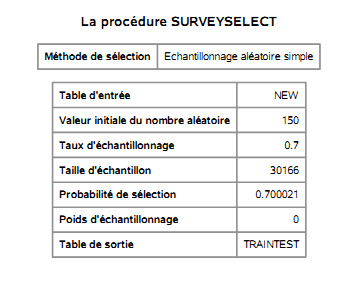
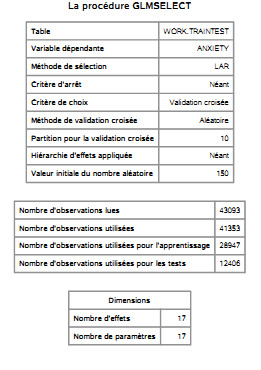
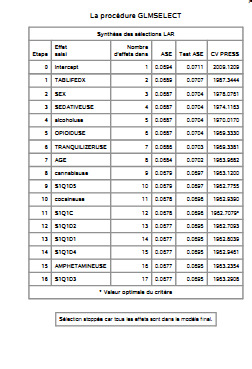
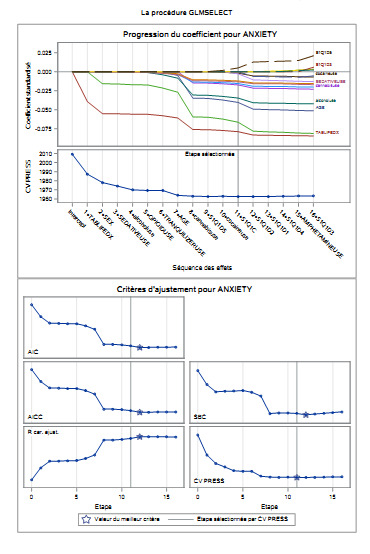
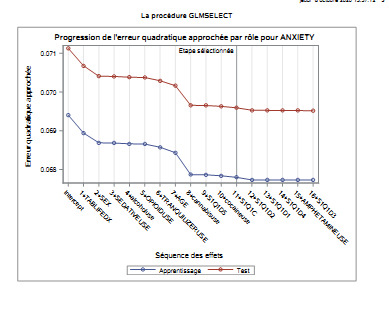
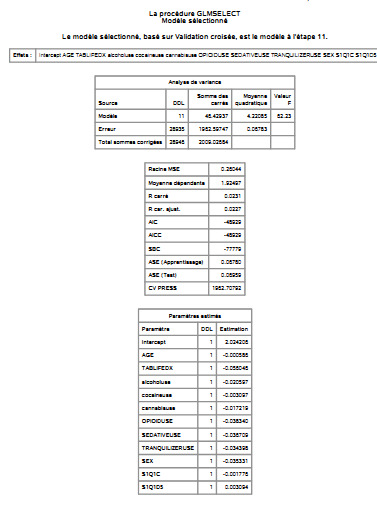
INTERPRETATION
We used The lasso regression analysis procedure to identify the best predictor variables measuring the GENERALIZED ANXIETY “S9Q1A”renamed “ANXIETY” (our target variable), from a pool of 16 categorical and quantitative predictor, wich are : age, gender, (race / ethnicity) Hispanic, White, Black, Native American and Asian. Alcohol use, marijuana use, cocaine use, AMPHETAMINE USE, OPIOID USE, SEDATIVE USE, and TRANQUILIZER USE.
. We have 41,353 observations used, out of the 43,093 observations read.we include the seed= 150 option to specify a random number seed to ensure that the data are randomly split the same way if I run the code again. And the samprate command, tells SAS to split the input data set so we have 70% (N=28947) of the observations are designated as training observations, and the remaining 30% (N=12406) are designated as test observations.
Finally, we used cvmethod=random, to use a K-fold cross-validation method with ten randomly selected folds, in which the first fold is treated as a validation set, and the model is estimated on the training data set using the remaining nine folds, and the model was validated using the test set. The change in the cross validation average (mean) squared error at each step was used to identify the best subset of predictor variables.
Of the 16 predictor variables, 11 were retained in the selected model. During the estimation process,
The Nicotine Dependence ,sex ,sedative use and alcohol use were, repectively, the most strongly and netatively associated with the ANXIETY. The rest of the other predictor variables retained are in decreasing order of importance of association with Anxiety was as follows:
OPIOIDUSE, TRANQUILIZERUSE, AGE, cannabisuse, white "S1Q1D5", cocaineuse, HISPANIC OR LATINO ORIGIN "S1Q1C", "ASIAN" S1Q1D2, "AMERICAN INDIAN OR ALASKA NATIVE" S1Q1D1, "NATIVE HAWAIIAN OR OTHER PACIFIC ISLANDER" S1Q1D4, AMPHETAMINEUSE, and rhe "BLACK OR AFRICAN AMERICAN" S1Q1D3. The estimated regression coefficients for the selected model was very weak (0.023).
0 notes
Text
Each Day Sober Slowly Helps Alcoholics' Brains Recover
Each Day Sober Slowly Helps Alcoholics’ Brains Recover
[ad_1]
Latest Mental Health News

WEDNESDAY, Sept. 2, 2020 (HealthDay News)
A new brain scan study shows why the “one day at a time” approach works for recovering alcoholics.
“For people with AUD [alcoholuse disorder], the brain takes a long time to normalize, and each day is going to be a struggle,” explained senior study author Rajita Sinha, a professor of…
View On WordPress
0 notes
Text
The effect of alcohol consumption on suicide rate
For my research , i am planning to investigate the effect of Alcohol consumption on the suicide rate . For my investigation, i will use the data gathered by the gap minder foundation for the average suicide and the average alcohol consumption rate across 170 countries gathered from the UN .
The average suicide rate per 100 person and the average alcohol consumption rate in liter per month are considered as a quantitative values. in order to identify the relationship between two quantitative values, we will use Pearson’s correlation , and thus identifying how significant and strong is the relationship between them .
The program i am using is the Python for coding, and the syntax for the code is shown below
# -*- coding: utf-8 -*- """ Created on Wed Aug 12 18:24:12 2020
@author: omar.elfarouk """
import pandas import numpy import seaborn import scipy import matplotlib.pyplot as plt
data = pandas.read_csv('gapminder.csv', low_memory=False)
#setting variables you will be working with to numeric
data['internetuserate'] = pandas.to_numeric(data['internetuserate'], errors='coerce') data['urbanrate'] = pandas.to_numeric(data['urbanrate'], errors='coerce') data['incomeperperson'] = pandas.to_numeric(data['incomeperperson'], errors='coerce')
data['alcconsumption'] = pandas.to_numeric(data['alcconsumption'], errors='coerce') data['incomeperperson'] = pandas.to_numeric(data['incomeperperson'], errors='coerce') data['suicideper100th'] = pandas.to_numeric(data['suicideper100th'], errors='coerce')
data['incomeperperson']=data['incomeperperson'].replace(' ', numpy.nan) data['alcconsumption']=data['alcconsumption'].replace(' ', numpy.nan) data['suicideper100th']=data['suicideper100th'].replace(' ', numpy.nan)
#Plotting figure scat1 = seaborn.regplot(x="incomeperperson", y="alcconsumption", fit_reg=True, data=data) plt.xlabel('incomeperperson') plt.ylabel('Alcoholuse') plt.title('Scatterplot for the Association Between income per personand Alcohol usage')
scat2 = seaborn.regplot(x="incomeperperson", y="suicideper100th", fit_reg=True, data=data) plt.xlabel('Income per Person') plt.ylabel('suicideper100th') plt.title('Scatterplot for the Association Between Income per Person and Suicide Rate')
scat3 = seaborn.regplot(x="alcconsumption", y="suicideper100th", fit_reg=True, data=data) plt.xlabel('Alcohol usage') plt.ylabel('suicideper100th') plt.title('Scatterplot for the Association Between Alcohol usage and Suicide Rate')
#Cleaning data data_clean=data.dropna()
#Applying pearson correlation print ('association between Income per person and Alcohole isage') print (scipy.stats.pearsonr(data_clean['incomeperperson'], data_clean['alcconsumption']))
print ('association between incomeperperson and suscide rate ') print (scipy.stats.pearsonr(data_clean['incomeperperson'], data_clean['suicideper100th']))
print ('association between Alcohol usage and suscide rate ') print (scipy.stats.pearsonr(data_clean['alcconsumption'], data_clean['suicideper100th']))
Regarding the average income and the alcohol correlation , there is a strong correlation as shown in the figure below
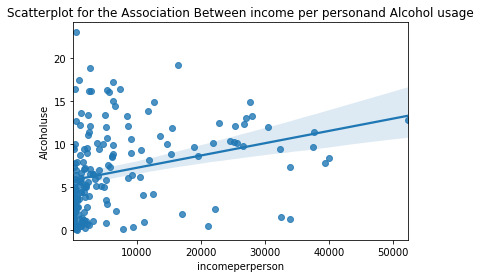
The relationship between income and suicide shows a weak correlation and insignificant effect as shown in the figure below
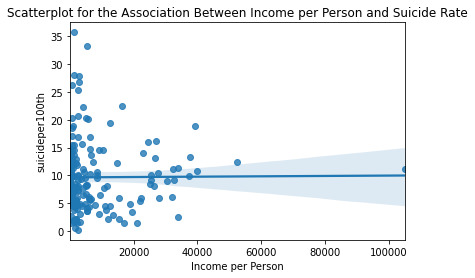
the relationship between the alcohol usage and the suicide rate displays a strong correlation as shown in the figure below.
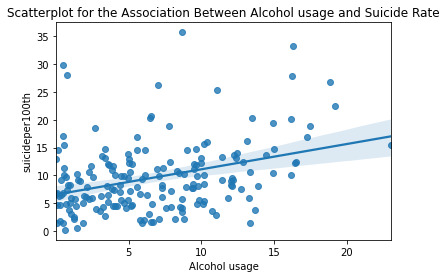
The Pearson correlation ,and the p-values are displayed as shown in the text below
association between Income per person and Alcohol usage (0.29177119807858265, 0.00010297020763990634)
Thus ,there is a weak positive correlation beween income per person and alcohol usage, However. it is considered as a significant as the p value is below 0.05, thus we can safely reject the null hypothesis and claim that there is a significant relation between the Alcohol usage and the income
association between income per person and suicide rate (0.0060833598985392135, 0.9368723631391026)
Thus ,there is a weak positive correlation between the income and the suicide rate, and also it is considered insignificant as the p value is equal to 0.93, thus we can safely accept the null hypothesis and claim that there no significant relation between the average income and the suicide rate. association between Alcohol usage and suicide rate (0.3874255193053243, 1.5168064802517918e-07)
Thus ,there is a weak positive correlation between suicide rate and alcohol usage, However. it is considered as a significant as the p value is below 0.05, thus we can safely reject the null hypothesis and claim that there is a significant relation between the Alcohol usage and the suicide rate.
0 notes
Text
Tweeted
Participants needed for online survey! Topic: "Alcohol Use and Sleep Quality" https://t.co/vGzLjgjddA via @SurveyCircle #IndianPopulation #AlcoholUse #SleepQuality #survey #surveycircle https://t.co/f3W45TLJsS
— Daily Research @SurveyCircle (@daily_research) Mar 9, 2023
0 notes